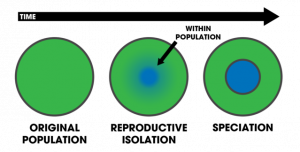Contents
Evolution & Speciation
Genetic Variation
The exact mechanisms of how genetic variation is introduced to a population through mutations and meiosis are introduced in topic 4. The first source of genetic variation is mutations, but meiosis and the random fertilization of gametes during sexual reproduction result in more genetic variation.
Recap question: What are the names of the two ways variation is introduced in meiosis?
Within a population, there will be competition for resources, and the impact of disease and predators results in the process of natural selection. Natural selection and the two types of selection were covered in topic 4.
Natural selection is when individuals within a population show a wide range of variation in phenotype. This is due to genetic and environmental factors. The primary source of genetic variation is mutation. Predation, disease, and competition result in selection pressures. Those organisms with phenotypes providing selective advantages are likely to survive. They are also likely to produce more offspring and pass on their favorable alleles to the next generation. The effect of this is a change in the allele frequency (evolution).
Recap question: What were the two types of selection called?
Individuals within a population that have a phenotype that makes them more able to survive and pass on their alleles to their offspring are described as having the selective advantage. This is differential reproductive success, as not all individuals are as likely to reproduce, and this results in changes in allele frequencies within a gene pool. Evolution is the term given to the change in allele frequencies in a population.
Below is a recap of the impact directional and stabilizing selection have on the allele frequency.
The final type of selection is disruptive selection. This is when individuals that contain the alleles coding for either extreme trait are more likely to survive and pass on their alleles. As a result, the allele frequency changes, and more individuals possess the allele for the extreme trait, and the middling trait allele becomes less frequent. Continued disruptive selection can ultimately lead to speciation.
Speciation
Speciation is the process that results in the creation of new species. This occurs when one original population of the same species becomes reproductively isolated. This isolation means that there are now two populations of the same species, but they cannot breed together. This can result in the accumulation of differences in their gene pools to the extent that the two populations would be unable to reproduce to make fertile offspring, and are therefore classified as two different species. There are two different ways that populations can become reproductively isolated, either geographically (allopatric) or because of changes in reproductive mechanisms (sympatric speciation).
Allopatric speciation
Populations can become separated geographically leading to reproductive isolation. Within all populations, there is genetic variation due to random mutations. A population could become geographically isolated over time by new mountain ranges or new bodies of water separating land masses, for example. This separates the original population into two, which are now unable to reproduce due to the geographical barrier. Both separate populations will continue to accumulate different beneficial mutations over time to help them survive in their environments, which are likely to vary. Due to this accumulation of DNA differences over time, the two populations become so genetically different that they would be unable to reproduce to create fertile offspring. They are, therefore, classified as two different species.
Sympatric speciation
Populations can also become reproductively isolated due to differences in their behavior. Individuals of the same species may not be separated by geographical barriers but are still unable to reproduce. This could be because a random mutation within the population could impact reproductive behavior, for example, it may cause individuals to perform a different courtship ritual or for individuals to be fertile at different times of the year. Due to this, these individuals will not reproduce together, and there will be no gene flow between the two groups within the populations. Over time, these reproductively isolated populations will accumulate different mutations to the extent that their DNA is so different that they cannot reproduce to create fertile offspring. They are, therefore, classified as two different species.
Genetic Draft
This is the change in the allele frequency within a population between generations. There will always be genetic drift from one generation to the next, but continual, substantial genetic drift results in evolution. The smaller a population is, the bigger the impact allele frequency changes have proportionally, and this is why evolution often occurs more rapidly in smaller populations.
- Explain why genetic drift is important only in small populations:
- Your answer should include: rapid / evolution
- Explain how evolutionary change over a long period of time has resulted in a great diversity of species:
- speciation




